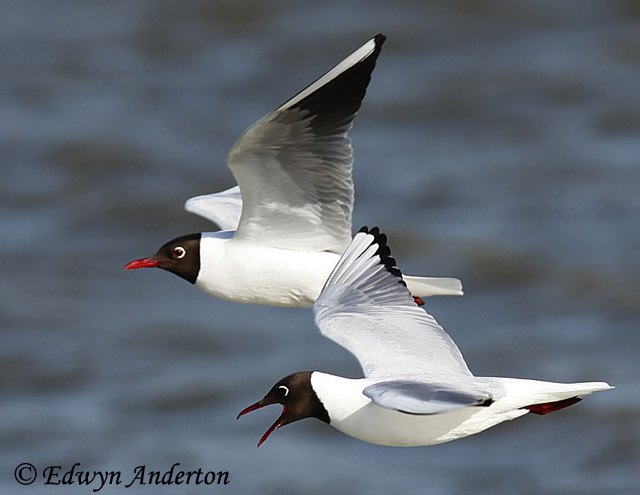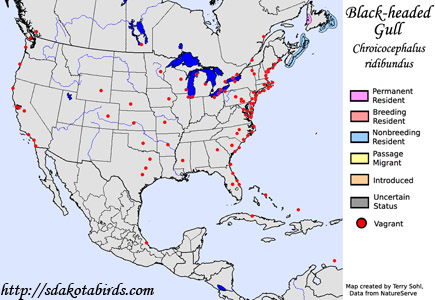| Length: 16 inches | Wingspan: 40 inches | Seasonality: Non-resident in South Dakota |
| ID Keys: Thin dark red bill, light gray mantle, white body, dark primaries on underwing. Dark brownish-black hood on breeding birds, mostly white with a few dark smudges on non-breeding birds. | ||
 The
Black-headed Gull is a species that is very common in Europe and Asia, but
is a relatively recent resident of North America. They were unknown in
North America until the 1920s, but scattered reports occurred for decades,
until nesting was confirmed in Newfoundland in the 1970s. They have
increased in number in North America since, with most birds found in
southeastern Canada, the northeastern United States, and around the Great
Lakes. However, they have also been identified in many other states,
including many locations far inland, and along the West Coast of the United
States. When found in North America, they are often found within
flocks of Bonaparte's Gulls.
The
Black-headed Gull is a species that is very common in Europe and Asia, but
is a relatively recent resident of North America. They were unknown in
North America until the 1920s, but scattered reports occurred for decades,
until nesting was confirmed in Newfoundland in the 1970s. They have
increased in number in North America since, with most birds found in
southeastern Canada, the northeastern United States, and around the Great
Lakes. However, they have also been identified in many other states,
including many locations far inland, and along the West Coast of the United
States. When found in North America, they are often found within
flocks of Bonaparte's Gulls.
Habitat: Found mostly around coastal areas with protected shallow waters, such as bays or estuaries. They are much less common on fresh water in North America, although in their Eurasian range, they are commonly found around freshwater lakes and rivers, far from the coast.
Diet: Omnivorous. Food items may include insects, small fish, crustaceans, mollusks, marine worms, other small invertebrates, and carrion.
Behavior: Uses a variety of foraging techniques, depending upon food item and location. They will often search for food while walking on the shore or in shallow water. They will also feed while swimming on the water's surface, or by flying over the water's surface and dipping down to grab food items when spotted.
Nesting: A colonial nester at most times, although they will occasionally nest as an isolated pair. The nest is a depression on the ground, lined with pieces of plant material. It is usually placed in semi-protected areas, next to vegetation. The female usually lays 2 or 3 eggs, and both parents help to incubate them. When the eggs hatch, both parents help to feed them. The young fledge at about 5 weeks.
Interactive eBird Map: Click to access an interactive eBird map of Black-headed Gull sightings
Song: Has a harsh, low-pitched, raspy grrrrr call.
Migration: In North America, most birds are found during the winter months off the eastern coast of North America. It is thought that many of these birds are summer breeders in Iceland. However, breeding has been confirmed in southeastern Canada, and some birds may be semi permanent residents in the area.
Similar Species: Most similar to North America's Bonaparte's Gull, but could also be confused with Franklin's Gull or Laughing Gull.
Conservation Status: Populations appear to be decreasing. However, they are still found over a very wide geographic area and are common in parts of their range. The Black-headed Gull is considered a species of "Least Concern" by the IUCN.
Further Information: 1) WhatBird - Black-headed Gull
2) BirdLife International - Black-headed Gull
3) Audubon Guide - Black-headed Gull
Photo Information: Photo taken by Edwyn Anderton - April 27th, 2012 - Dunwich, England - Photo licensed under Creative Commons Attribution NonCommercial ShareAlike 2.0 Generic License.
| Click below for a higher-resolution map |
 |
| South Dakota Status: Non-resident in South Dakota |
Additional Black-headed Gull Photos (coming soon!!)
